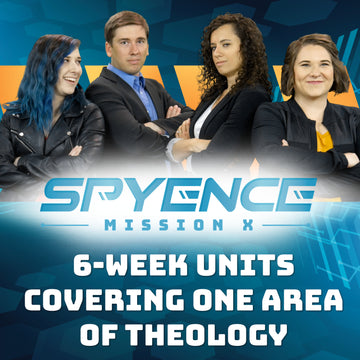Do kids need Systematic Theology?
Admit it: Systematic Theology sounds boring. You may be thinking, “I don’t want to teach theology. I just want the next generation to learn to love Jesus.”
Yes! Me too! And... the moment you start explaining who Jesus is, what He did, and why that matters, you’re “doing” theology. Theology is literally logos (words or study) about theo (God).
Anytime you teach kids, teens, or young adults about the Father’s love, or the Son’s sacrifice on the cross, or the Spirit’s leading and guiding, you’re sharing words about God (in other words, you’re doing theology).

R.C. Sproul says, "No Christian can avoid theology. Every Christian is a theologian. Perhaps not a theologian in the technical or professional sense, but a theologian nevertheless. The issue for Christians is not whether we are going to be theologians but whether we are going to be good theologians."
And good theology is especially important for kids and teens. Why? Because they’re right in the thick of forming their worldview and identity – a process that forces them to contemplate big questions about God:
• How do I know God is real?
• Why did Jesus have to die?
• Will I go to Heaven?
• Can I mess up so badly God won’t forgive me?
• Why did God make Satan?
• If God is in control of everything, does anything I do matter?
These are theological questions, and they deserve solid theological answers that are well-thought-out, true-to-real-life, and rooted in Scripture. We’ll look at the specifics of teaching systematic theology later in this chapter, but first, let’s define some terms…
Theology vs. Systematic Theology

What’s the difference between theology in general and systematic theology? Let’s start with a simple comparison: If you were teaching kids biology, you could do it two ways – sharing random facts or following a logical framework.
Clearly, teaching Biology using a logical framework (i.e., systematically) will lead to a deeper understanding and will be more useful for kids. Using a logical framework doesn’t make biology less interesting. It fits the interesting facts into a bigger picture.
The same is true for theology.
“Regular” theology gathers truths and stories about God from the Bible. So, say you start in Genesis and read right through to Revelation – you will learn a ton of truths about who God is, our relationship to Him, and the plans God has for us.
Systematic theology arranges all those truths in a logical framework.
Another way to say that is: It fits those truths into a unified Biblical worldview.
Systematic Theology is just Bible Facts, Organized

For example, take everything you learned about God Himself as you read from Genesis to Revelation, and organize all those facts about God in a systematic way, and that’s called Theology Proper (the study of God Himself), which is a subcategory of systematic theology.
Then take everything you learned about salvation from Genesis to Revelation, and organize it in a systematic way, and that’s Soteriology (the study of salvation), which is another subcategory of systematic theology.
Keep filling in more areas of Biblical teaching – what we can learn about the Bible itself, the church, Jesus, the Holy Spirit and our Identity in Chirst, Prayer & Worship, the Attributes of God, then doctrines specific to Easter (firstfruits) and Christmas (incarnation) – and eventually you’ll form a well-rounded systematic theology.
And that’s exactly what we want to pass on to kids – a framework for a thoroughly Biblical worldview that informs a thoroughly Biblical personal identity. Like the young lady in this illustration:

And just like teaching biology systematically will result in kids growing up with a more useful understanding of biology, teaching kids systematic theology will result in kids growing up with a more robust, well-rounded, useful Biblical worldview that informs their identity.
The Picture on the Top of the Puzzle Box

Every Sunday, kids in our churches learn a “piece” of the Biblical story:
• God created Adam and Eve
• Adam and Eve did bad things and got kicked out of the garden
• God sent a huge flood but saved one family and two of each animal
• Something about a Passover lamb
• Something about a guy swallowed by a whale
• Etc.
Each Sunday’s Bible lesson is like another puzzle piece kids add to their collection, and those puzzle pieces are valuable. But systematic theology gives kids the picture on the puzzle box. It shows where every piece belongs and makes sense of all the individual lessons.
And kids are not the only ones who benefit from seeing the big picture on the puzzle box. Systematic theology also helps your adult leaders teach with confidence. Let me use another illustration…
An Emergency Room for Big Questions

Think of systematic theology as the triage station in a well-run emergency room. The triage station identifies an incoming patient’s injury and routes the patient to the right doctor in the right department.
Systematic theology is similar -- it helps teachers sort the questions kids ask into the right “department.”
Let’s look at some examples:
Kids ask: “Church can be boring. Why do I have to go?”
Teacher Responds: “Great question about the church (Ecclesiology). We studied the theology of the church. What did we learn? I think the first thing we learned was that the most common picture the Bible uses of the church is “Christ’s body.” Let’s think about that. What does it mean for us to be parts of a body...”
Kids ask: “How can God hear everyone’s prayers at the same time?”
Teacher Responds: “That’s a great question about God (Theology Proper). Remember we studied God and looked at His attributes. I think two of them were omnipresence and omniscience. Who remembers what omnipresence means? …
Kids ask: “Why did Jesus have to die?”
Teacher Responds: “That’s a great question that relates to how God saves us (Soteriology). Do you remember when we studied justification? Do you remember how God dealt with the bad things we’ve done? Yes, through the cross...”
Instead of improvising answers week by week, teachers can use systematic theology to pull every question into the big picture of what the Bible teaches.
They can show kids how all the individual puzzle pieces fit together: how God’s holiness puts sin in perspective, how the cross makes forgiveness possible, how the Spirit empowers spiritual growth, and how God’s plan for us in eternity gives us hope. It all fits together beautifully, like interlocking puzzle pieces.
But Isn’t Systematic Theology Dry?
You may still encounter people who don’t appreciate the idea of teaching kids theology. A common objection is that teaching theology is all about the mind – just giving kids intellectual knowledge – and not the heart. Nothing could be further from the truth. Listen to what A.W. Tozer said:

If Tozer’s right and the Holy Spirit’s presence floods our hearts via theological knowledge, how exactly does that work?
Professor John Tweeddale explains it this way: “Theology is important because what you believe about God transforms your mind, shapes your heart, informs your will, changes your behavior, and fuels your worship.”
What you believe about God (your theology) changes your mind, heart, will, behavior, and worship!
Or as Wayne Grudem, who wrote the book on Systematic Theology (literally), puts it, systematic theology answers the question, “What does the whole Bible teach us today about any given topic?”
The whole point of Systematic theology is to organize God’s truth so we can get to know Him better today.
To sum up what we’ve covered so far, let me quote J.T. English and Jen Wilkin:
What is theology? Words about God.
Who does theology? Everybody.
What does theology do? It organizes biblical truths.
Why does theology matter? Because living well matters.
Simply put, theology is part of a life well lived. Theology helps us live all of life well.
Okay, now it’s time to get practical. What exactly are best practices for teaching Systematic Theology in Next Gen ministry?
Systematic Theology For Kids

We have lots of ideas on how to make theology fun, exciting, practical, and memorable for kids. We’ll get into all those ideas, but first…
Here are what we believe are the three essential elements for any lesson teaching theology to kids:
1. Introduce the theology concept and a simple definition
2. Provide a Biblical explanation
3. Connect it to a key Bible verse or passage
We’ll illustrate those elements with an example from the Spyence Systematic Theology Curriculum for kids.
The following is from a lesson that teaches kids about evidence for God’s existence from the unit on Theology Proper:
1. Introduce the theology concept and a simple definition
Talk about how detectives use evidence to come to conclusions and solve a case, and “spiritual detectives” do the same thing – specifically, they look for evidence that God is real.

2. Provide a Biblical explanation
Discuss with kids some of the “clues that God is real” from the Bible. For example, the beautiful world He created (Psalm 19:1-4), the miracles Jesus performed (Mark 4:39-41), the vastness of our universe (Isaiah 40:25-26), and the resurrection of Jesus (1 Corinthians 15:3–8).

3. Connect it to a key Bible verse or passage
Walk kids through Romans 1:20, where Paul says that even though God is invisible, you can see evidence for Him from what He has made.

If you follow those three steps and introduce your kids to a robust set of theology terms – justification, sanctification, revelation, inspiration, transcendence, mercy, grace, etc. – you’ll be doing them a huge favor.
But those are just the essential elements. Now let’s add in some extras and make these important truths even more memorable.
What we want to do is use interactive activities to improve your kids’ focus during the lesson and extend their retention afterward. In fact, incorporate as many interactive activities as possible into each lesson to take your systematic theology teaching to the next level.
Here are three examples of bonus ways to make your theology lessons stick.
Making The Truth Stick
Use interactive activities to improve your kids’ focus during the lesson and extend their retention afterward.
Incorporate as many interactive activities as possible into each lesson to take your systematic theology lessons to the next level.

Here are three examples:

1. Hands-On Activity: Let kids illustrate the concept in their own hands to really lock it in. (Bonus if they make something so cool they want to take it home and show it to their friends.)
Now I know using hands-on activities is nothing new to you all, but I just want to point out and emphasize that you CAN do fun hands-on activities that illustrate concepts in systematic theology. As abstract and conceptual as systematic theology can be, you can still do hands-on activities, and in fact, I’d say it’s especially important to do hands-on activities for systematic theology.
According to the textbook Educational Psychology: Developing Learners, “people of all ages can more readily understand and remember abstract information when they connect it to concrete objects…” (Ormrod, Anderman, & Anderman, 2023, p. 6).
Example: Kids make the Twirly-Whirly science experiment. When they drop it, air pushes against the wings, causing it to fall slowly as the wings rotate. The tie-in to the lesson: Even though you can’t see air, you can see evidence that the air is there by how it slows and spins the Twirly-Whirly. And even though you can’t see God, you can see evidence that He is real in the beautiful Earth, in Jesus’ miracles and resurrection, and in the gigantic size of the planets and stars in our universe.

2. Story-Driven Video: Use narrative and humor to introduce the doctrine you’re focusing on. (Bonus if the video contains real stakes – real consequences on the line – to grab and hold kids’ attention.)
Why this works: Research shows that humans are created to crave story (Jesus’ parables, anyone?) and that stories can rewire a learner’s brain in powerful ways. (Wired for Story, Cron, 2012)
Example: An evil robot turns invisible and sneaks into Spyence Headquarters. As the Spyentists gather evidence to locate the robot, Secret Agent K explains that tracing clues to an unseen intruder is like examining clues that the invisible God exists.
3. Memory Verse Motions: Have kids stand up and memorize the key verse together using fun hand motions so bodies help brains remember. (Bonus if the teacher facilitates as the kids come up with the motions themselves.)
Why this works: Gesturing while learning ties language to action systems in the brain (dual coding/enactment), so that students who learn with self-produced gestures remember more and longer. (Cook, Mitchell, & Goldin-Meadow, 2008).
Example: In this lesson, kids make up motions to help them memorize Romans 1:20. The teacher encourages them to be creative, giving them an example: to illustrate “God’s invisible qualities," cover your eyes and mime feeling all around with your hands like you’re looking for an invisible God while saying, “God? God? Are you there?” The more humorous the actions, the more they'll stick in your students’ minds and aid their memorization, so encourage students to think outside the box.

Putting It All Together For Kids
Let’s put all those ideas together. Here’s how a theology‑infused lesson might unfold on a Sunday:
- Opening Game: Gets kids comfortable, having fun, and ready to learn.
- Story-Driven Video: Grabs kids’ attention, introduces the theology term, and leads right into the teacher’s lesson.
- Theology Term: Name the lesson’s focus theology term, define it in simple language, and let the kids practice saying it.
- Teacher‑Led Bible Exploration: An interactive lesson takes kids into the Bible to learn about the theology concept. The teacher asks for responses to gauge understanding and reinforces points that are unclear.
- Bible Verse: Kids memorize a key verse using motions to make it memorable.
- Hands‑On Experiment: Kids illustrate the concept in their own hands to really lock it in.
- Small‑Group Application: Kids discuss the lesson in small groups and get to ask their questions and apply the lesson to concrete scenarios. Kids also get to share prayer requests and pray for each other.
- Take‑Home Mission Guide: Provides a one‑page recap for parents, plus questions to discuss with their kids to go deeper into the lesson at home.
- Review: When kids return to class the next week, the lesson starts with a 5-minute review of last week’s theology concept.

What about Chronological Bible Studies and Topical Bible Studies?

The short answer is: chronological Bible study and systematic theology are like the two rails on a railroad track – both are necessary and complementary.
Chronological Bible Study is the story rail. Kids (and leaders) meet key people and places in context and learn how God’s promises unfold. They see the big story, from the garden in Genesis, the entrance of sin and its ripple effects, God’s covenant promises, Jesus’ birth, life, death, and resurrection, the mission of the church, and finally the judgment at the end of time and the garden city paradise on the New Earth in Revelation 21 and 22.
Systematic theology gives the framework rail. It organizes the big story's teachings so that every new puzzle piece fits into a coherent worldview.
Kids should experience both rails before they graduate from elementary school so they move into middle school with the story pieces and a doctrinal understanding of what they mean and how they fit together.
What about topical studies (heroes of the Old Testament, parables of Jesus, the fruit of the Spirit, etc)? These can be good, but be aware that they aren’t anchored to a plan, which means some doctrines will get overemphasized while others never get taught.
Click here to see a chart showing which kidmin curriculum are chronological, systematic, or topical (scroll down to the bottom of the page).
Conclusion: Systematic Theology – Helping Kids Form a Biblical Worldview
We’ve covered many reasons to make sure Systematic Theology is a part of your children's ministry curriculum. Let’s review some of the benefits, lumping them together into some big categories:
Logical Worldview: The next generation needs to see how Bible doctrines fit together (e.g., God’s holiness → our sin → Christ’s atonement → justification → sanctification → glorification). Systematic theology connects the dots so they can answer life’s hardest questions with God’s truth, instead of just guessing or going with whatever their friends or social media say.
Shared Vocabulary: Naming big truths (justification, Trinity, incarnation, inspiration) gives kids, teens, young adults, leaders and parents shared language for discipleship.
Application: Because we ask, “What does the whole Bible teach and what does that mean for me today?” doctrine naturally connects to worldview, identity, purpose, relationships, habits, priorities, and every other area of life.
Let me close with Dallas Willard’s thoughts on this subject:
One of the greatest weaknesses in our teaching and leadership today is that we spend so much time trying to get people to do things good people are supposed to do, without changing what they really believe...
We frankly need to do much less of managing of action, and especially with young people.
We need to concentrate on changing the minds of those we would reach and serve. What they do will certainly follow, as Jesus well understood and taught...
When we bring people to believe differently, they really do become different.
Additional Resources:
-
Click here for more systematic theology quotes, helpful theology books, curriculum recommendations, etc.
- Click here to read the second half of this article, focusing on Systematic Theology for Teens and Young Adults.
Summary Infographic:

Note: This blog post was originally written for a chapter in the upcoming Next Gen Ministry Textbook for the KidMin Academy. Check back for details about the book's release.






